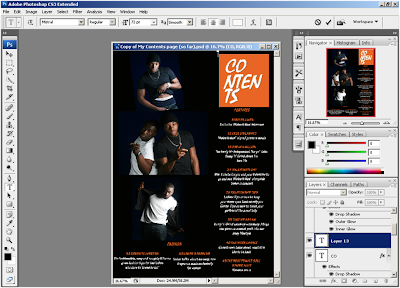In creating my music magazine I have acquired some useful skills and some skills that I have previously possessed have been nurtured. There were many tasks I had to undergo before making my magazine including planning and research and other things I did not expect to do. Doing this all independently helped me with my time management and organisational skills. I had to decide on who I wanted to use as models for my magazine, plan and arrange suitable times for all of us so that I could take my photographs.
Constructing my front cover and contents page was slightly more straightforward as they are both A4 canvases but when I was going to start producing my double page spread I had to open a new file, use an A3 canvas and rotate it 90 degrees. By doing so, the page became landscape which is what I wanted. Evidently I have learnt quite a fair amount about Photoshop considering I had never really used it before. Two very useful things I’ve learnt are how to place an image onto a canvas and how to move an image from one canvas to another.
I chose my font cleverly and strategically. When I decided on the genre of my magazine and what I would call it, almost immediately I had an idea of the type of font I’d use. I wanted something swirly but not too fancy that it’d be illegible. Also, I knew that I’d use the Times New Roman font as this is my favourite font and it looks decent and elegant. I understand how important it is to pick the right and most suitable fonts as fonts tend to have a key impact on the reader and how they perceive the product. A font can determine whether a potential consumer buys (or reads) a magazine or not.
Ultimately, creating my three pieces and all the pre-production and post-production tasks has taught me the importance of evaluating my work. Evaluating makes you think about what you did and why you did it, this enables you to see what you could do next time to improve your work.


































